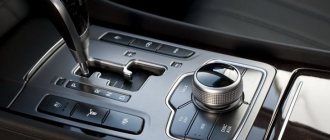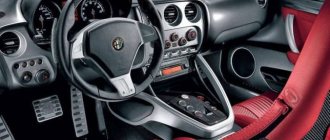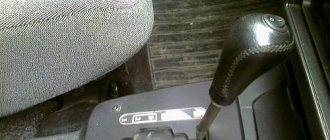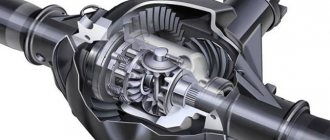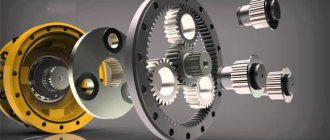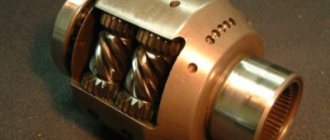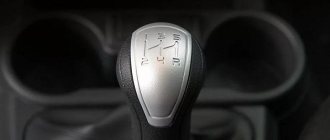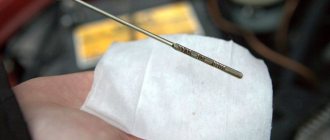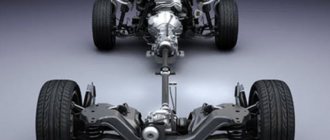A manual gearbox is a unit in which gear selection and engagement is carried out manually, mechanically. Due to the limited range of operation of vehicle engines, a transmission is used to expand the operating capabilities of the internal combustion engine and adapt to different driving conditions.
The main function of a manual transmission, like any other, is to adapt and transmit torque to the wheels by changing the gear ratio. In a manual transmission, this is done manually by selecting the appropriate gear for the situation. Torque in a manual transmission is carried out in stages.
The prototype for creating an automatic transmission was a manual transmission. Understanding the principle of its operation will give an understanding of the essence of the functioning of almost any transmission.
According to the number of steps there are:
- four-speed (mostly on old cars, now extremely rare);
- five-speed (most common);
- six-speed.
Types of manual transmission according to the number of available shafts:
- two-shaft (mainly installed on front-wheel drive passenger cars);
- three-shaft (installed on front-wheel drive and rear-wheel drive vehicles, both cars and trucks).
The robotic gearbox is a modern, improved manual transmission; gear shifting occurs using electrical mechanisms controlled by an electronic unit. Some modes in the “robot” are similar to automatic transmission modes, while others require selection of a mode. There is no clutch pedal.
Manual transmission - characteristics
Starting the story about the gearbox, it’s worth briefly understanding - why is it needed at all? After all, everyone knows that the main thing in a car is the engine, so is it really impossible to directly transfer the work it does to the wheels, without inventing complex schemes with a bunch of gears, a third pedal in the cabin and a lever that must be constantly turned? Unfortunately no.
The best way to answer this obvious question is to look at the bicycle, or rather its evolution. The simplest option consists of two sprockets connected by a chain drive. By rotating one - the driving - sprocket with the help of pedals, the rider sets in motion the second - the driven one, connected directly to the wheel, thus rotating it.
The bicycle moves forward, everyone is happy and satisfied. At least, they were up to a certain point - as long as the bicycle was used to move on relatively flat and horizontal surfaces. Having suddenly found out that sometimes there are hills, loose soils and other inconveniences along the way, people started thinking about improving the design. The result was what can be called the prototype of a manual transmission - sets of sprockets at the front and rear, allowing you to change the gear ratio.
The gear ratio is a quotient obtained by dividing the speed of the driving star by the speed of the driven one, that is, the number of their revolutions. It is the inverse of the gear ratio, which is calculated as the ratio of the number of teeth on the driven sprocket to the number on the drive sprocket. Simply put, the smaller the driving star and the larger the trailing star, the easier it will be to rotate and the slower it will move.
Again we remember the old bicycles: the front pedals had to rotate a large sprocket, while the sprocket on the rear hub was small. As a result, when trying to get going in some Ural as a child, you had to put all your weight on the pedals to turn the rear wheel. Well, now stores are replete with a scattering of two-wheelers, even the most budget ones of which have several stars in the back and front.
Thanks to this, you can, for example, change the set: the driving sprocket will be small, and the driven sprocket will be large. Then the pedals will rotate very easily, but you won’t be able to accelerate much. But it will be possible to ride up the hill, rather than drag it.
Purpose of the checkpoint
The gearbox is designed for several tasks:
- torque changes,
- speed changes,
- correcting the direction of movement of the car,
- disconnecting the internal combustion engine and transmission and, on the contrary, connecting them (this need is relevant when changing gears, the need to obtain low “creeping” speeds, and short-term stopping of the vehicle),
- locking the torque converter (the function is valuable for reducing the loss of useful energy of the “automatic” when transmitting torque in a situation where the speed of the driven and driving turbines is equalized).
At the same time, some gearboxes are capable of solving all these problems, while others, such as a mechanical one, only do the basics - changing torque and speed. The design of the device depends on the type of gearbox. The housing of the gearbox with “mechanics” combines shafts (2, 3 or more), a synchronizer, gears, a gear shift lever, wire rings, bearings, and oil seals.
New developments in the world of gearboxes
The current variety of gearboxes is not a frozen collection of metal, but one that absorbs everything new - the world of gearboxes. However, conventional boxes, which appeared simultaneously with the advent of the car, have the lowest rate of development, and robotic ones have the highest, while the latter cease to be ordinary modernized boxes, moving further and further away from them - full control of electronics and drives affects, and their design is already underway using its own special technology. That is, these boxes are, in fact, increasingly moving away from the mechanics that gave birth to them.
This can be seen in the results - the best robotic gearboxes from Ferrari provide gear changes in no more than 60 ms, and DSG gearboxes (Volkswagen) are capable of switching individual gears in 8 ms! Thanks to this, a Volkswagen Golf, for example, equipped with a 7-speed gearbox of this type, is approximately 20% more economical than the same car, but equipped with a traditional “mechanics”.
In recent years, the characteristics of lubrication systems have sharply improved - currently produced gearboxes are often equipped with a pressure lubrication system, and sometimes even shared with the engine. This solution makes it possible to dramatically increase the service life of the gearbox relative to the usual lubrication system due to the oil present in the engine crankcase, as well as to ensure the necessary cooling of the gearbox due to constant oil circulation. Today there are already quite a large number of manual transmissions, but they use ATF oil for their lubrication, that is, automatic transmission oil.
In conclusion, it is worth saying that the trend of our time is that the design of a manual transmission is becoming more and more complex in the pursuit of dynamics, speed, efficiency... What it will be like in the future is difficult to say, probably no one will say.
Manual transmission device
A manual transmission consists of a clutch basket and the gearbox itself. The power unit includes:
- crankcase (housing);
- primary, secondary and intermediate shafts;
- stage selection device;
- driven and driving sets of gears;
- synchronizers;
- bearings, couplings and seals.
All these components are located in the housing and interacting with each other transmit torque.
Clutch
Designed to transmit torque from the flywheel of the internal combustion engine crankshaft to the input shaft of the gearbox. It is thanks to the presence of the clutch that the engine can be carefully disconnected from the transmission for a short period of time, and the transmission can be protected from overloads. The standard clutch on most manual transmission vehicles includes the flywheel, pressure plate, driven plate, throwout bearing, drive, fork, and clutch switch. One engine is connected to the wheels, the other to the internal combustion engine. The moment the driver releases the pedal, the discs are pressed against each other and begin to rotate together.
It is the classic clutch as such that is most often talked about when using a manual transmission, and when driving with an internal combustion engine on an automatic transmission they talk about a combined solution of the clutch and torque converter. Its immediate function is similar to that of a clutch. But the driver does not need to perform any routine actions and press the clutch manually. The checkpoint itself will do everything for him.
As for robotic solutions such as DSG (with mechatronics), they have two clutches. The presence of two clutches is valuable for increasing the power of the vehicle, while minimizing slippage and optimizing fuel consumption. Indeed, physically, at the moment of switching, the engine speed when using two clutches can remain at the same level. In the picture below you see the “behavior” of the clutch in the DSG robotic gearbox at the moment after switching to second gear.
Gears and shafts
In standard manual transmissions, the shaft axes are located parallel, and gears are located on them. The drive (primary) shaft is connected to the engine flywheel through the clutch basket; the longitudinal projections located on it move the second clutch disc and transmit torque to the intermediate gear through a rigidly fixed drive gear.
In the shank of the drive shaft there is a bearing, to which the end of the secondary shaft is adjacent. The absence of a fixed connection makes it possible for the shafts to rotate independently of each other in different directions and at different speeds. The driven shaft has a whole set of different gears, both rigidly fixed and freely rotating.
The movement and selection of the required pair of gears for the distribution of torque corresponding to the conditions of movement is carried out by shift forks using a two-way control mechanism.
The gear shift rod consists of a lock, a gear shift clutch, drives, sliders with forks that move lengthwise and crosswise using the gearshift handle located inside the car, and a drive. The gear selection mechanism can be located either in the transmission housing or on the body of the vehicle and, in rare cases, on the steering column. In most cases, a rocker mechanism is used to drive the gear rod.
Synchronizers
Synchronizers are an integral element of a gearbox with gears - except for solutions with sliding gears. Physically, the work of synchronizers is due to the force of friction. The function of synchronizers is to equalize the rotation speed of gears and shafts, thereby creating all the conditions for smooth gear shifting. Thanks to synchronizers, the gearbox wears out less and makes less noise. Synchronizers are actively present in manual transmissions and robotic gearboxes. For cars with planetary automatic transmissions, an alternative to synchronizers is friction control elements. Synchronizers consist of a clutch, locking rings, a retaining ring, a spring, and gears.
How does a standard synchronizer work?
- The clutch is fed towards the gear.
- The clutch locking ring absorbs the force.
- The tooth surfaces begin to interact.
- The locking one acquires the position “on the stop”.
- The teeth of the coupling are opposite the teeth of the locking ring.
- The clutch engages with the ring gear.
- The clutch and gear are blocked.
It would seem that there are quite a lot of steps, but all this happens in a fraction of seconds - at the moment the driver engages the gear.
Clutch
The clutch mechanism is necessarily included in the design of all manual transmissions. It serves to interrupt the flow of power from the engine to the gearbox. This must be done so that the rotation speeds of the gears can be equalized when switching.
Most cars use a dry, single-plate friction clutch. Its components:
clutch housing;- clutch basket with a diaphragm spring (aka drive disc);
- clutch driven disc;
- release bearing;
- clutch release fork;
- shutdown drive (hydraulic or cable);
- off pedal.
The principle of operation of the clutch: in the normal state it is closed, the driving and driven disks fit tightly to each other. The driver opens it by pressing the corresponding pedal. Then, through a hydraulic or cable drive, the impact is transmitted to the clutch release fork, which, through a release bearing, moves the driven disk away from the drive one, and the engine and manual transmission are separated.
Types of manual transmissions
Based on the number of stages, a manual transmission is mainly divided into:
- 4-speed;
- 5-speed;
- 6-speed.
The most common mechanics is the 5MT transmission, i.e. five-speed gearbox. Depending on the number of shafts, the following types of gearboxes are distinguished:
- two-shaft mechanical transmissions installed on front-wheel drive passenger cars;
- three-shaft manual transmissions, which are used mainly on rear-wheel drive cars, as well as on trucks.
In addition to the number of shafts and stages, gearboxes are classified depending on the presence or absence of synchronizers. If they are not there, switching gears requires a certain time, which is reduced by adjusting the box and manipulating the gas and clutch pedals. Such manual transmissions are more reliable under high loads, therefore they are installed on motorcycles, sports cars, agricultural machinery, and heavy trucks, in which synchronization cannot be used for technical reasons.
Robotic boxes are also classified as mechanical. Their design is the same, including the presence of a clutch disc, but the control is carried out by electronics that perform the functions of a pedal. The switching pattern is also no different.
Classifications of modern manual boxes
By number of gears
All boxes are conventionally divided into types depending on the number of gear stages they implement. There are 4-, 5-, 6-, and even 7-speed gearboxes. The increase in the number of gears is based on the need to transmit torque within the most efficient limits. So, if the engine has the greatest torque at relatively low speeds, then there is no point in accelerating it to higher speeds - the power it develops will only fall as the rotation speed increases. In such situations, a much more effective solution would be to use an appropriate box;
By number of shafts
Gearboxes come in 3- and 2-shaft types depending on how many shafts they contain. 3-shaft gearboxes (described above) are equipped with cars with both front- and rear-wheel drive, and 2-shaft gearboxes are mainly equipped with front-wheel drive passenger cars. A 2-shaft box, as the name suggests, contains only two shafts, although in general their arrangement and purpose are similar to a 3-shaft box. The differences lie in the location of the shafts relative to each other - it is parallel in a 2-shaft box. The second difference is in the gear creation scheme - in a 3-shaft gearbox, one gear is implemented by two pairs of gears, and in a 2-shaft gearbox - by only one pair. 2-shaft boxes do not have direct transmission, but they can have not one, but several driven shafts at once.
Advantages of manual transmissions:
- the cost and weight of the “mechanics” are relatively lower than the same parameters for other types of boxes;
- The efficiency of “mechanics” is higher than that of other types of boxes;
- due to its high reliability, the “mechanics” have a long service life;
- a manual transmission provides a wide choice of driving styles in various vehicle operating conditions, for example, off-road, mud, ice;
- If necessary, a car with a manual transmission can be towed anywhere without fear of unpleasant consequences from the transmission;
- the presence of a manual gearbox makes it possible to start the car from a pusher and allows the transmission to be disconnected from the engine.
Disadvantages of manual transmissions:
- during long driving around the city or in traffic jams, it tires the driver much more; the driver needs certain driving skills, such as smooth transitions between gears;
- a relatively long time for changing gears, since it requires temporarily disconnecting the gearbox from the engine (disengaging the clutch);
- relatively short resource of the clutch mechanism.
Operating principle of a manual transmission
The operating principle of a manual transmission is as follows: torque from the engine is transmitted through the clutch to the input shaft of the gearbox, then converted using pairs of interacting gears and then transmitted to the wheels.
Each pair of gears (stage) has a specific gear ratio that converts the rotation speed and torque of the engine crankshaft. Moreover, if the gear increases the torque, then the rotation speed decreases and vice versa. In the first case, the gear will be called a reduction gear, and in the second – an overdrive. The gear ratio is determined by the ratio of the number of teeth on the output and input gears in a pair.
In turn, the number of teeth directly depends on the size of the gear itself: the more teeth, the larger the diameter of the gear. For example, first gear has the largest gear ratio, and therefore the input gear (on the input shaft) is the smallest size and the output gear is the largest. Shifting gears in a manual transmission occurs only when you press the clutch pedal, since it is necessary to interrupt the flow of power transmitted from the engine.
The movement of a car equipped with a manual transmission always begins in first gear. The exception is heavy trucks - there this can be done from second gear. To do this, you must manually move the lever selector to the appropriate position. The transition to higher gears is carried out by sequentially changing gears one after another. The timing of the gear shift itself depends on the speedometer and tachometer readings, since each gear is designed to operate in a certain engine speed range.
Operating principle and design of a two-shaft manual transmission
The essence of the operation of a manual transmission is to create connections between the primary and secondary shafts by varying gears with different numbers of teeth, which adapts the transmission to the constantly changing circumstances of the vehicle's movement. For people ignorant of these issues, the essence of the functioning of a manual transmission can be explained in a simplified manner, in order to understand the essence of the issue.
This power unit provides the necessary operating modes of the engine by changing the number of revolutions, changing the transmitted force to the drive wheels. Accordingly, when the number of revolutions decreases, the transmitted force decreases, and when the number increases, it increases. This is necessary when maintaining the required engine operating mode when starting to move, reducing speed or accelerating.
The two-shaft manual transmission consists of:
- driving and driven shaft;
- gears of the drive and driven shafts;
- main gear;
- differential;
- synchronizers;
- gear shift mechanism;
- body - crankcase.
Most modern front-wheel drive cars are equipped with a two-shaft manual transmission. In such transmissions, torque is transmitted from the input shaft gears to the driven gears. The drive shaft is connected to the motor through a flywheel, and the driven shaft transmits torque to the front wheels. They are located in parallel.
Without an intermediate shaft, typical of three-shaft manual transmissions, the dimensions of the unit are smaller, as is the weight, but the increased number of gears leads to a decrease in efficiency. The compact size of this transmission allows it to be installed on heavy motorcycles. Parallel to the primary shaft, on which the gears are mounted, there is a secondary shaft with a set of gears. The shaft gears constantly interact with each other and at the same time rotate freely on the axis.
The main gear drive gear is firmly fixed on the secondary shaft. Between the gears there are synchronizer clutches. To reduce the size of the unit and to increase the number of stages, up to three secondary shafts are installed, each of them has a main gear gear, which constantly interacts with the driven gear.
The main gear and differential transform the torque of the secondary shaft to the drive wheels of the machine. The differential allows the wheels to rotate at different speeds, which becomes noticeable when one of the drive wheels hits a slippery surface. The gear shift mechanism is usually located outside the transmission housing. The connection between it and the transmission is carried out using cables and rods. The simplest and most common is switching using cables.
The structure of the gear shift mechanism:
- stage selection cable and control lever;
- gear shift cable and gear selection lever;
- gear shift rod with forks and gear shift handle;
- blocking lock.
When selecting steps, the control lever moves transversely, and when turned on, it moves longitudinally. The principle of operation of a two-shaft box is in many ways similar to the functioning of a three-shaft box. The main distinguishing principle is some specificity of the operation of the switching stage of the mechanism. When a specific speed is turned on, the control lever will move both longitudinally and transversely. During transverse movement, the force is transferred to the cable, which acts on the gear selection lever, which, in turn, rotates the rod around the axis and facilitates the selection of the required gear.
Operating principle and design of a three-shaft manual transmission
The fundamental principle of the operation of a manual transmission is the gear interaction of gears, which are enveloped in transmission fluid located in the gearbox housing.
This manual transmission includes:
- driving and driven shafts;
- intermediate and additional shafts;
- frame;
- synchronizers;
- gear sets;
- gear switching mechanism with locks and locking mechanisms;
- gear shift lever.
Bearings located in the housing ensure rotation of the shafts. Each shaft has a set of gears with a different number of teeth. The drive shaft is connected to the engine via a clutch basket, the driven shaft is connected to the cardan shaft, and the intermediate shaft transmits torque to the secondary one. There is a drive gear on the input shaft, which spins the intermediate gear with a firmly fixed set of gears located on it. The driven shaft has its own set of gears moving along splines.
Between the gears of the secondary shaft there are synchronizer clutches, which equalize the angular speeds of the gears with the revolutions of the shaft itself. The synchronizers are firmly attached to the shafts and move longitudinally along splines. On modern manual transmissions, such clutches are located at each stage. The gear switching device in a three-shaft manual transmission is most often located on its body. The basis of its design is the control handle and sliders with forks. A locking mechanism is present to prevent synchronous selection of two degrees.
The degree switching device can be controlled remotely from the steering column. At the neutral stage, torque is not transmitted to the wheels, since the input shaft is disconnected from the engine by the clutch. When the position of the control handle changes, a fork similar to the position moves the synchronizer clutch, equalizing the rotation speeds of the corresponding gear and the secondary shaft.
The toothed part of the synchronizer begins to interact with the gear halo and it is locked on the secondary shaft and torque is delivered with the required gear ratio to the wheels.
The movement of vehicles back is carried out with the assistance of the appropriate stage. Changing the direction of rotation occurs with the participation of the reverse intermediate gear, which is located on a separate axis. Three-shaft manual transmissions are bulky and heavy, but their clear advantage is the direct transmission of torque from the first shaft to the second, which gives greater efficiency. Installed on rear-wheel drive and all-wheel drive cars and trucks.
Operating principle
In order for the driver to engage the required gear, it is necessary to temporarily disconnect the engine and the input shaft of the manual transmission. In manual transmissions, the clutch serves this purpose. In cars, disc clutches are used that use the friction force between the working surfaces of two disks - the drive and the driven.
By squeezing the clutch pedal, the driver disconnects the engine and gearbox, being able to use the control lever to change pairs of gears that are in mesh. But the shafts of the box, even when disconnected from the engine using the clutch, continue to rotate. At the same time, their rotation speed is different. Therefore, the teeth of the gears that mesh are not aligned with each other and collide with each other with force. The load arising in this case is very large and reduces the service life of parts. To reduce the negative effect of a collision, designers introduced synchronizers into the mechanical gearbox.
The synchronizer is a clutch with internal teeth and conical gear rings. The gears of a synchronized gearbox have conical surfaces that match the surfaces of the rings. Operating principle: equalization of rotation speeds occurs due to friction forces arising between the gears and rings of the synchronizer clutch.
Advantages and disadvantages of manual transmission
There are no ideal units and mechanisms. Advantages and some disadvantages are also characteristic of a manual transmission. The main advantages of such a product include the following:
- The cost of a manual transmission is significantly lower than the cost of an automatic equivalent or a DSG gearbox.
- It does not require special cooling conditions and has high efficiency in contrast to a hydromechanical device.
- Simplicity of design, well studied by experts.
- Reliability, high service life.
- Easy to repair and does not require special maintenance.
- A manual car starts easily by pushing.
- It provides the car with dynamism, while not requiring serious fuel costs, which cannot be said about automatic transmissions, cars with which consume more fuel.
- Significantly smaller dimensions and weight.
As you can see, there are many advantages of mechanics, the list can be continued indefinitely, but we will only focus on the main “trump cards” of the unit. It is also important to note some of the disadvantages of such a gearbox, which will help the driver better navigate when choosing a car with a certain type of gearbox:
- Mechanical boxes are structurally reliable, but the clutch often fails prematurely.
- It takes time for new drivers to understand how a gearbox works.
- When switching from one gear to another at low speeds, the power plant loses power.
- During long journeys, the driver of a manual car quickly gets tired due to the constant need to switch from high to low gear and vice versa.
However, the advantages of mechanics are significantly greater than the disadvantages. Cars with manual transmission still remain in demand and popular. But, according to statistical data, motorists in many European countries are gradually switching to cars with automatic transmissions and CVTs. The share of sales of manual cars fell by 10-15% everywhere.
Peak development - robots
Electronics came to the rescue in the difficult task of improving the design of a manual transmission. With its help, they implemented control of gear shifting without driver participation. Such gearboxes are called robotic. Remaining structurally mechanical, and having in their device such a part as a friction clutch, they take on the process of squeezing and switching.
This device allows you to maintain the relative simplicity of the box itself and get closer to the control comfort of automatic transmissions. But having gotten rid of a number of manual transmission shortcomings, the new units acquired their own, unique to them.
Since the clutch mechanism has not gone away, a problem has arisen: when starting off on an incline, the car rolls back. This is due to the fact that when the driven and driven discs are opened, nothing holds the car - at this moment the driver moves his foot from the brake pedal to the accelerator. The problem can be solved in two ways - by making adjustments to the control algorithm, forcing the car to release pressure in the brake system with a delay, or by introducing a second clutch into the design. Then, when switching, one of them remains closed.
How to use a manual transmission
Using a car with a manual transmission has some features that a car enthusiast needs to know. First, this is the sequence of actions when starting the machine:
- depress the clutch pedal all the way and move the gearshift lever to the neutral position; if you have doubts whether the speed has been selected correctly, you need to move the lever handle to the sides; when the gearshift handle is in the neutral position, the lever moves freely to the right and left;
- when moving the car to neutral, it is necessary to secure the vehicle to avoid uncontrolled movement; to do this, the car is put on the handbrake or the brake pedal is depressed;
- When the clutch is depressed and the car is held with the brake, you need to turn the ignition key, the icons on the instrument panel should light up, as soon as almost all the icons go out, you should further turn the key and after starting the engine, release the key.
Secondly, the switching pattern for manual transmission. It is most often located on the outer part of the lever handle. When changing gear, it is recommended to focus on the tachometer. You can switch to a higher gear by spinning the engine speed to 1500–2000 rpm in the case of a diesel engine and up to 2000–2500 rpm in the case of a gasoline engine. Thirdly, the gear shift process. It consists of several stages:
- release the gas pedal;
- Press the clutch pedal all the way with your left foot;
- move the lever by hand to the required position;
- Gently release the clutch pedal and slowly press the accelerator pedal.
Fourthly, regularly checking the fluid level and replacing it according to the manufacturer’s instructions will extend the life of the manual transmission.
Repair and replacement of VAZ boxes
Classic VAZ cars had manual transmissions. They are easy to use and have a long service life. They are simply repaired compared to other types. Many owners do this themselves. If you don’t want to waste time on this, you can purchase a new unit and install it in place of the old one.
WATCH THE VIDEO
Now you know what a gearbox is. Which types of checkpoints to choose is up to everyone to decide for themselves. It all depends on personal preferences and habits. Don't forget about regular maintenance, diagnostics and repairs, otherwise your car's gearbox will quickly fail.
